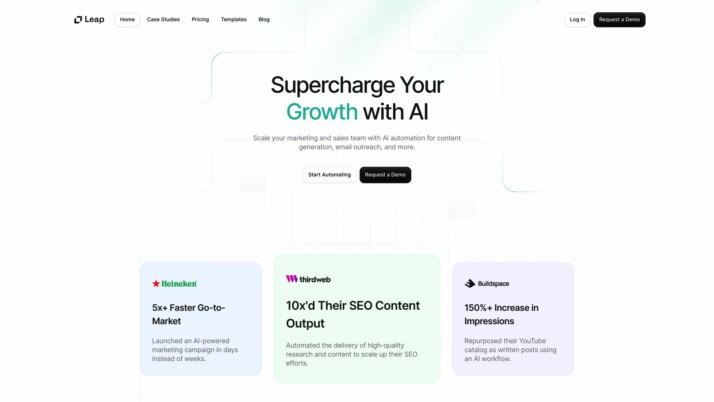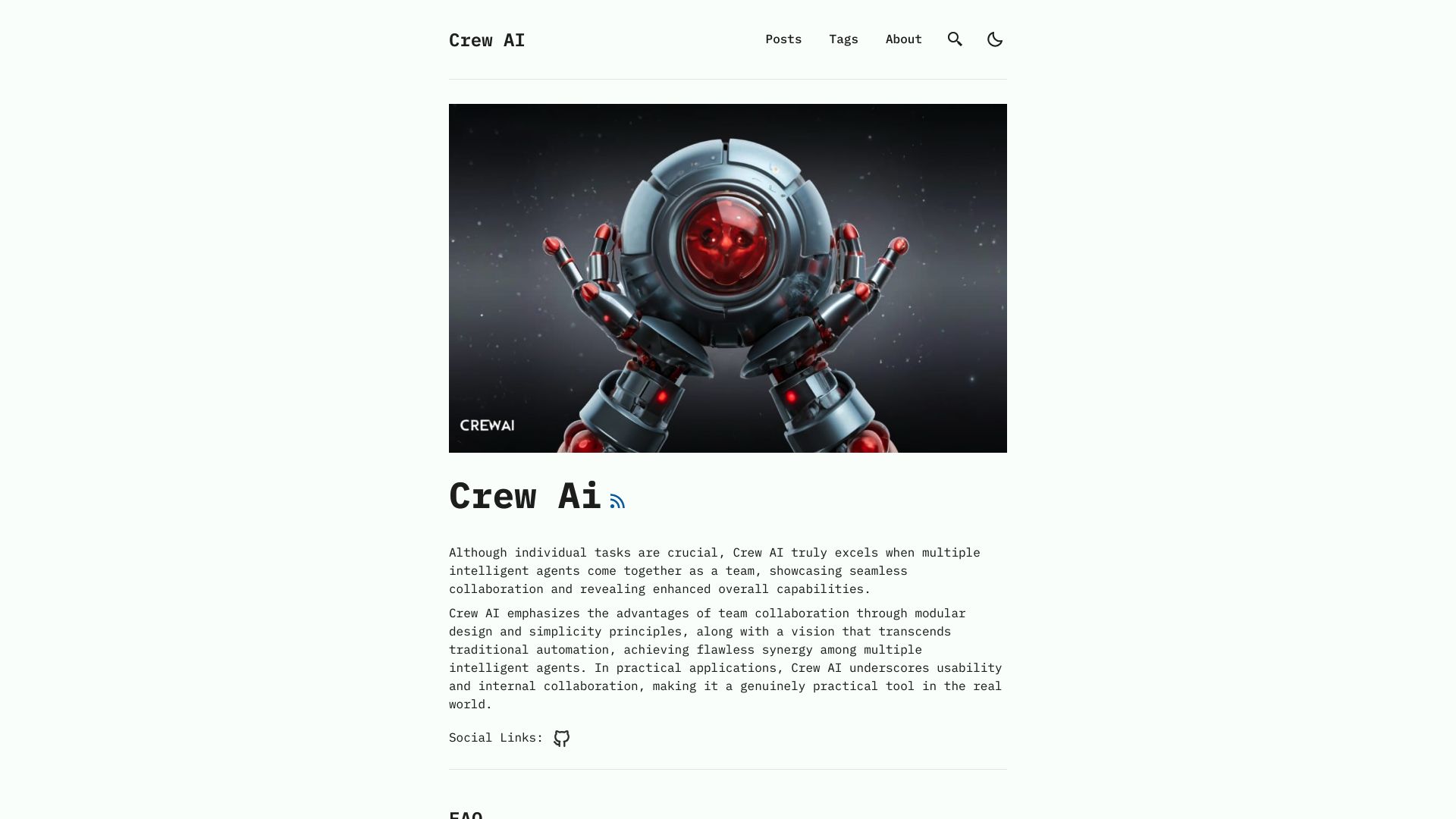Leap AI vs. CrewAI: Comparing No-Code and Collaborative AI Platforms
AI technologies reshape industries daily, yet finding the right platform to harness this power remains a challenge. This comparison delves into Leap AI vs. CrewAI, and SmythOS, three distinct AI platforms catering to different needs. Leap AI offers no-code AI workflow creation, while CrewAI focuses on orchestrating collaborative AI agent teams. SmythOS emerges as a comprehensive solution, combining user-friendly interfaces with advanced AI capabilities. We’ll explore each platform’s strengths, limitations, and ideal use cases, empowering you to make an informed decision for your AI development needs. Whether you’re a seasoned developer or a business leader exploring AI integration, this analysis provides valuable insights to guide your choice in the evolving AI landscape.
Leap AI Overview
Leap AI empowers users to create sophisticated AI workflows without coding expertise. The platform combines a user-friendly visual interface with powerful AI capabilities, enabling rapid development of intelligent applications across industries.


At its core, Leap AI offers a no-code environment for building AI-driven workflows. Users can leverage drag-and-drop tools and pre-built templates to construct complex AI processes, from text generation to image creation and music composition. The platform integrates seamlessly with popular AI models like OpenAI GPT, Mistral 7b, and Stable Diffusion XL, providing access to cutting-edge AI technologies.
Leap AI empowers users to create sophisticated AI workflows without coding expertise. The platform combines a user-friendly visual interface with powerful AI capabilities…
Leap AI excels in its integration capabilities, connecting effortlessly with widely-used tools such as Slack, HubSpot, and Zapier. This versatility allows businesses to incorporate AI functionalities into existing workflows, enhancing productivity across various departments. The platform’s comprehensive SDK support, including RESTful API, TypeScript, and Python options, further expands its utility for developers seeking deeper customization.
While Leap AI offers impressive features for rapid AI deployment, it faces some limitations. The platform lacks certain advanced capabilities like autonomous agents, constrained alignment, and hosted vector databases. Additionally, its debugging tools and explainability features are not as robust as some competitors, potentially impacting troubleshooting and transparency in complex AI systems.
Leap AI’s vision centers on democratizing AI technology, making advanced capabilities accessible to a broader audience. By providing a low-code/no-code solution, the platform aims to empower businesses and individuals to harness AI for automating tasks, improving efficiency, and driving innovation. This approach aligns well with the growing demand for AI solutions that don’t require extensive technical expertise, potentially accelerating AI adoption across various sectors.
Leap AI’s vision centers on democratizing AI technology, making advanced capabilities accessible to a broader audience.
CrewAI Overview
CrewAI empowers developers to orchestrate collaborative AI agent teams for complex task execution. This open-source framework enables the creation of specialized agents with defined roles, goals, and skills to work together in structured workflows.


CrewAI’s Python library allows developers to configure AI agents, assign tasks, and manage collaboration through customizable processes. The platform’s role-based agent design ensures clear objectives and backstories shape agent behavior. Flexible task delegation enables autonomous handoffs and collaboration between agents.
CrewAI empowers developers to orchestrate collaborative AI agent teams for complex task execution. This open-source framework enables the creation of specialized agents with defined roles, goals, and skills…
The framework integrates human-in-the-loop capabilities, allowing agents to incorporate human input when needed. CrewAI’s process-driven approach ensures coordinated teamwork between agents through structured workflows. This modular architecture invites community contributions, fostering the development of tools and extensions to expand CrewAI’s capabilities.
While CrewAI offers powerful collaboration features, it lacks some advanced functionalities found in other platforms. The framework doesn’t provide hosted agents or environments, limiting deployment options. Additionally, CrewAI doesn’t include built-in debugging tools or extensive explainability features, which may challenge troubleshooting and transparency efforts.
Despite these limitations, CrewAI’s open-source nature and focus on agent collaboration position it as a valuable tool for developers seeking to build sophisticated multi-agent AI systems. As the platform evolves, it aims to become a robust foundation for collaborative AI development, enabling creative applications across various industries.
Feature Comparison
Leap AI and CrewAI offer distinct approaches to AI agent development, with notable differences in their core components and security features. Leap AI provides a user-friendly visual interface for building AI workflows without coding, integrating easily with popular AI models and third-party tools. However, it lacks some advanced capabilities like autonomous agents and constrained alignment. CrewAI, as an open-source framework, focuses on orchestrating collaborative AI agent teams, enabling developers to create specialized agents with defined roles and goals. While powerful for multi-agent systems, CrewAI doesn’t offer hosted environments or built-in debugging tools.
In terms of security, Leap AI implements multi-layer encryption and supports OAuth for secure authentication, addressing some enterprise-level concerns. CrewAI, being primarily a development framework, leaves security implementation largely to the developers. This gap in built-in security features may require additional effort from users to ensure robust protection of their AI systems. Both platforms have room for improvement in areas like explainability and transparency, which are crucial for building trust in AI systems, especially in regulated industries.
Feature Comparison Table
| Leap AI | CrewAI | SmythOS | |
|---|---|---|---|
| CORE FEATURES | |||
| Hosted Agents (Dev, Production) | ❌ | ❌ | ✅ |
| Environments (Dev, Production) | ✅ | ❌ | ✅ |
| Visual Builder | ✅ | ❌ | ✅ |
| No-Code Options | ✅ | ❌ | ✅ |
| Autonomous Agents | ❌ | ✅ | ✅ |
| Explainability & Transparency | ❌ | ❌ | ✅ |
| Debug Tools | ❌ | ❌ | ✅ |
| Multimodal | ✅ | ❌ | ✅ |
| Multi-Agent Collaboration | ❌ | ✅ | ✅ |
| Audit Logs for Analytics | ✅ | ❌ | ✅ |
| SECURITY | |||
| Constrained Alignment | ❌ | ❌ | ✅ |
| Data Encryption | ✅ | ❌ | ✅ |
| OAuth | ✅ | ❌ | ✅ |
| IP Control | ✅ | ❌ | ✅ |
| COMPONENTS | |||
| Foundation AIs | ✅ | ❌ | ✅ |
| Huggingface AIs | ✅ | ❌ | ✅ |
| Zapier APIs | ✅ | ❌ | ✅ |
| All other APIs, RPA | ✅ | ❌ | ✅ |
| Classifiers | ✅ | ❌ | ✅ |
| Logic | ✅ | ❌ | ✅ |
| Data Lakes | ❌ | ❌ | ✅ |
| DEPLOYMENT OPTIONS (EMBODIMENTS) | |||
| Deploy as API | ✅ | ❌ | ✅ |
| Deploy as Webhook | ✅ | ❌ | ✅ |
| Staging Domains | ✅ | ❌ | ✅ |
| Production Domains | ✅ | ❌ | ✅ |
| API Authentication (OAuth + Key) | ✅ | ❌ | ✅ |
| Deploy as Site Chat | ✅ | ❌ | ✅ |
| Deploy as Scheduled Agent | ✅ | ❌ | ✅ |
| Deploy as GPT | ✅ | ❌ | ✅ |
| DATA LAKE SUPPORT | |||
| Hosted Vector Database | ❌ | ❌ | ✅ |
| Sitemap Crawler | ✅ | ❌ | ✅ |
| YouTube Transcript Crawler | ✅ | ❌ | ✅ |
| URL Crawler | ✅ | ❌ | ✅ |
| PDF Support | ✅ | ❌ | ✅ |
| Word File Support | ✅ | ❌ | ✅ |
| TXT File Support | ✅ | ❌ | ✅ |
Best Alternative to Leap AI and CrewAI
SmythOS emerges as the superior alternative to Leap AI and CrewAI, offering a comprehensive platform for AI agent development and deployment. We combine the best aspects of both competitors while addressing their limitations, providing users with unparalleled flexibility and power.
Our drag-and-drop interface rivals Leap AI’s user-friendly approach, allowing users to create complex AI workflows without extensive coding knowledge. However, we take it a step further by offering autonomous agents and multi-agent collaboration capabilities that surpass both Leap AI and CrewAI. This empowers users to build sophisticated AI systems that can handle a wide range of tasks independently.
SmythOS emerges as the superior alternative to Leap AI and CrewAI, offering a comprehensive platform for AI agent development and deployment.
Unlike CrewAI’s open-source framework, which requires significant development effort, SmythOS provides a fully-hosted solution with both development and production environments. This approach streamlines the deployment process, allowing users to focus on innovation rather than infrastructure management. We also offer robust debugging tools and explainability features, addressing a critical gap in both Leap AI and CrewAI’s offerings.
Security is a top priority for SmythOS. We implement advanced features like constrained alignment, data encryption, and IP control, providing enterprise-grade protection that goes beyond Leap AI’s basic security measures and fills the void left by CrewAI’s lack of built-in security features. This makes SmythOS an ideal choice for businesses dealing with sensitive data or operating in regulated industries.
With SmythOS, users gain access to a vast ecosystem of integrations, including foundation AI models, Hugging Face libraries, and support for various APIs and data formats. This extensive compatibility, combined with our scalable architecture and diverse deployment options, ensures that SmythOS can adapt to virtually any use case or industry requirement. Whether you’re building a simple chatbot or a complex multi-agent system, SmythOS provides the tools and flexibility to bring your AI vision to life efficiently and effectively.
Conclusion
Leap AI and CrewAI offer unique approaches to AI development, but SmythOS emerges as the superior choice for businesses seeking comprehensive AI solutions. While Leap AI provides a user-friendly interface for building AI workflows and CrewAI focuses on orchestrating collaborative AI teams, SmythOS combines the best of both worlds with additional powerful features.
SmythOS stands out with its extensive integration ecosystem, supporting over 300,000 integrations and a wide range of AI models. This versatility allows businesses to seamlessly incorporate AI into existing workflows across various platforms. The platform’s drag-and-drop interface democratizes AI development, making it accessible to both technical and non-technical users.
Unlike its competitors, SmythOS offers advanced capabilities such as multi-agent orchestration, versatile deployment options, and robust security features. These elements provide the flexibility and scalability necessary for enterprise-level AI implementations. The platform’s ’Create Once, Deploy Anywhere’ approach further simplifies the process of integrating AI solutions across multiple environments.
For those ready to experience the future of AI automation, SmythOS offers a risk-free trial with unlimited agents and a 30-day money-back guarantee. Explore our diverse range of AI-powered agent templates to jumpstart your AI journey, or dive into our comprehensive documentation to understand the full potential of SmythOS. Take the first step towards revolutionizing your business processes with SmythOS – where innovation meets simplicity in AI development.
Last updated:
Disclaimer: The information presented in this article is for general informational purposes only and is provided as is. While we strive to keep the content up-to-date and accurate, we make no representations or warranties of any kind, express or implied, about the completeness, accuracy, reliability, suitability, or availability of the information contained in this article.
Any reliance you place on such information is strictly at your own risk. We reserve the right to make additions, deletions, or modifications to the contents of this article at any time without prior notice.
In no event will we be liable for any loss or damage including without limitation, indirect or consequential loss or damage, or any loss or damage whatsoever arising from loss of data, profits, or any other loss not specified herein arising out of, or in connection with, the use of this article.
Despite our best efforts, this article may contain oversights, errors, or omissions. If you notice any inaccuracies or have concerns about the content, please report them through our content feedback form. Your input helps us maintain the quality and reliability of our information.
